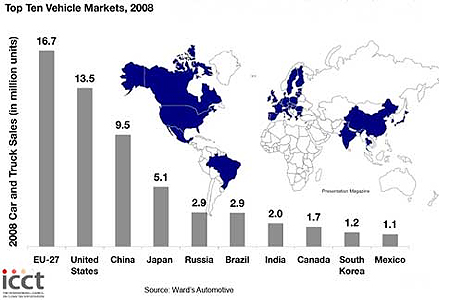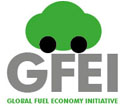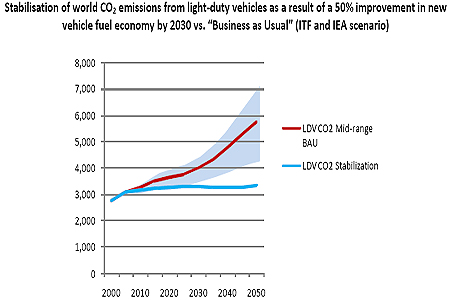
Trends and scenarios
EmissionsEnergy
Global LDV Growth
"For the management of future greenhouse gas emissions from transport, our analysis strongly suggests that technologies to improve fuel economy and ultimately transform the energy basis of transport are key, as there are very strong upward pressures on demand volumes."
Transport Outlook 2010, OECD/ITF
Emissions
The International Energy Agency (IEA) has estimated that fuel consumption and emissions of CO2 from the world’s cars will roughly double between 2000 and 2050.
CO2 emissions from fossil fuel combustion will increase 45% from 2006 to 2030, with 97% of this increase occurring in non-OECD countries. One-fifth of this increase is the result of global transport-related GHG emissions –98% of which will occur in non-OECD countries.
In order to support global reductions in CO2 emissions from the transport sector, technical innovation will have to go hand-in-hand with supporting policies – and there is a clear opportunity to improve new car fuel economy 30% by 2020 and 50% by 2030.
Improving the efficiency of new cars, from incremental technology improvements and hybridisation, at this rate would make possible a 50% improvement in the average fuel economy of all cars on the road worldwide by 2050, likely to be cost effective even at relatively low oil prices.
Today the transport sector is responsible for 23 - 24 percent of global CO2 emissions from fossil fuel combustion (with road transport 17-18 percent of this total) (see figure 4), and is expected to grow to one-third by 2050. The transport sector has the highest CO2 emissions growth of all sectors; aviation and road transport are drivers of this growth.
Net negative CO2 reduction costs are achievable at least for much of this improvement. But it is important that the efficiency gains are not simply offset by trends toward even larger, heavier, and faster cars.
Energy
IEA scenarios predict world transport energy use and emissions to increase by more than 50 percent by 2030 and more than double by 2050. The fastest growth is expected to come from air travel, road freight and light-duty vehicles, with road transport accounting for the bulk of growth.
From 1971 to 2006, global transport energy use rose steadily at between 2% and 2.5% per year, closely paralleling growth in economic activity around the world. Since 2000, transport energy use in OECD countries grew by an average of just over 1% per year between 2000 and 2005, rather than the 2% per year in previous decades.
Global LDV Growth

The overall scenario and projection, according to the IEA (2009) is that OECD countries are nearing or have reached saturation levels in many aspects of travel, whereas non-OECD countries – and especially rapidly developing countries such as China and India – are likely to continue to experience strong growth rates into the future through to at least 2050.
In OECD countries, the biggest increases in travel appear likely to come from long-distance travel, mainly by air.
In non-OECD countries, passenger LDV ownership and motorised two-wheeler travel are likely to grow rapidly in the decades to come, although two-wheeler travel may eventually give way to passenger LDV travel as countries become richer.
The world’s light duty vehicle fleet is set to at least triple by 2050, at which time two-thirds of the global vehicle fleet will be found in non-OECD countries (compared to about a quarter today). The total stock of LDVs is expected to grow to at least 2 billion by 2050 and possibly much higher, depending especially on ownership trends in countries such as China and India.








